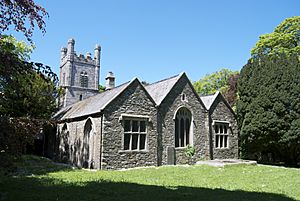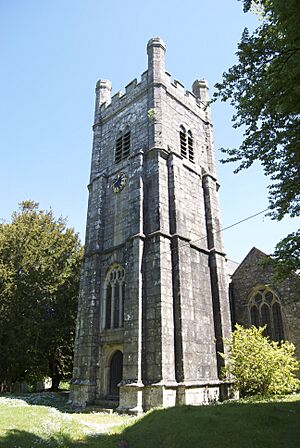St Andrew's Church, Calstock facts for kids
Quick facts for kids St. Andrew's Church |
|
|---|---|

St. Andrew's Church, after the grave stones were moved in 1967
|
|
| Type | Church |
| Location | Calstock, Cornwall |
| Built | 14th century |
|
Listed Building – Grade I
|
|
| Official name: Church of St Andrew, Calstock | |
| Designated | 19 October 1987 |
| Reference no. | 1140252 |
| Lua error in Module:Location_map at line 420: attempt to index field 'wikibase' (a nil value). | |
St. Andrew's Church is an old church in Calstock, Cornwall, England. It was built in the 1300s and is considered a very important historic building. It is officially recognized as a Grade I listed building, which means it has special historical or architectural importance.
Contents
A Look Back: The Church's History
The church stands on a hill overlooking the town, right where a Roman fort was recently discovered. This shows how old the area is! People believe the church was first made sacred around 1290. While not much from that very early time is still visible, some parts like the pillars and arches on the north side of the main aisle are from the early 1300s.
Around 1420, a new section called the south aisle was added, and the entire church got a new roof. Over the years, the church was fixed up many times. However, in 1861, a report said the church was in a "sad state" with old, messy seating and lots of "rubbish."
This led to a big restoration project in 1867. It cost £600 and was managed by Mr. James Piers St Aubyn, a famous architect who restored many churches in the West Country. During this work, the floor levels were changed, new tiles were laid, and the main part of the church (the chancel) got its current roof. The church also received new, simple wooden pews. Even though it was a big change, many interesting old parts of the church were carefully saved.
Outside the Church: What to See
When you look at the outside of St. Andrew's Church, you'll notice large granite blocks, especially in the tower and porch. These blocks usually mean that part of the church was built in the 1400s. The north and south walls seem to have been rebuilt at some point. It's likely that the criss-cross window designs you see were added in the 1700s, replacing older window styles.
A small tower-like structure sticking out from the north wall, built in the 1400s, holds a staircase that once led to a rood screen (a screen that separated the main part of the church from the altar). East of this small tower, you can see granite cornerstones that show where the north aisle originally ended. Beyond this point, built with different stone, is the Edgcumb Chapel, added in 1558. You can see the initials "R.E." (for Richard Edgecumb) above its door. The south aisle of the church was also made longer to match the north aisle. This extended part of the south aisle includes a vestry, which was already there before 1861.
The Impressive Tower
The church tower is very tall and has three main sections. It has strong supports (buttresses) and a decorative top (battlemented), making it a striking landmark. It used to have pointed decorations called pinnacles on top of its turrets.
In 1790, a big storm hit the church. The Exeter Mercury newspaper reported that lightning struck the tower, knocking down the western pinnacles and damaging the steeple all the way down to the bell room. From the tower, the lightning went through the church and "tore the altar piece to shivers."
The second section of the tower has a large stained glass window facing west. At the top of this window, there are four family crests. The first crest belongs to the Scorrer family, who owned the Harewood Estate about 1 kilometer east of the church.
The Church Porch
The porch, which is the entrance area of the church, has some interesting features:
- In the northeast corner, you can still see parts of a holy water font.
- There's a fireplace in the southwest corner with a granite top and sides. Fireplaces in church porches are quite rare, though a few exist in Devon. No one is completely sure why they were there. It might have been used to light the Easter fire, or perhaps to help keep diseases out of the building, following old ideas about cleanliness.
- The stone floor at the entrance has traces of brass nails. This suggests that a statue or carving might have once been placed there, perhaps as part of a tomb.
The Churchyard: A Place of History
At the eastern end of the churchyard, a granite cross marks the grave of Sir William Lewis Salusbury-Trelawny, 8th Baronet. He was a very important person, serving as the Lord Lieutenant of Cornwall and a Member of Parliament for East Cornwall. He lived at Harewood Estate and passed away there in 1856 at the age of 75. Local stories say that Sir William wanted his body to stay on his estate, so he was carried through the back gate to his burial spot, which is the closest to his home.
Inside the church, just north of the pulpit, there are two special plaques:
- One plaque has "Lau Deo" (meaning "Praise God") written at the top. Below it are the names of Sir William's four oldest children. Sadly, the oldest of them lived to be only 28.
- The other plaque shows an image of a cross with "Beneath The Cross" written on it. Below that, Sir William and his wife are shown. Below them is their fifth child, who died in middle age.
Other gravestones in the churchyard tell stories of people who died in mining and other industrial accidents. Even though the church is now in a quiet countryside area, in the 1800s, it was surrounded by busy industrial activities. People in the parish worked in quarrying (cutting stone), brickmaking, lime burning, boat building, and copper mining. The entrance to an old, not very successful, copper mine called Wheal Trelawny still runs underneath part of the churchyard.
You can also find the gravestone of two Shadrak brothers in the churchyard. They decided to move to Canada to find work after the Tamar Valley Mine closed. Sadly, they were among the 3,000 people on board the Titanic during its first voyage, which ended in disaster.
The Edgcumb Chapel
The Edgcumb Chapel is located at the eastern end of the northern aisle of the church. It contains two monuments from the late 1600s. These are dedicated to Piers Edgcumb (who died in 1666) and to Jemima, Countess of Sandwich (who died in 1674).
The Rectory
The rectory, which is the house where the church's rector (a type of priest) lives, was designed by Decimus Burton and built between 1853 and 1854.



